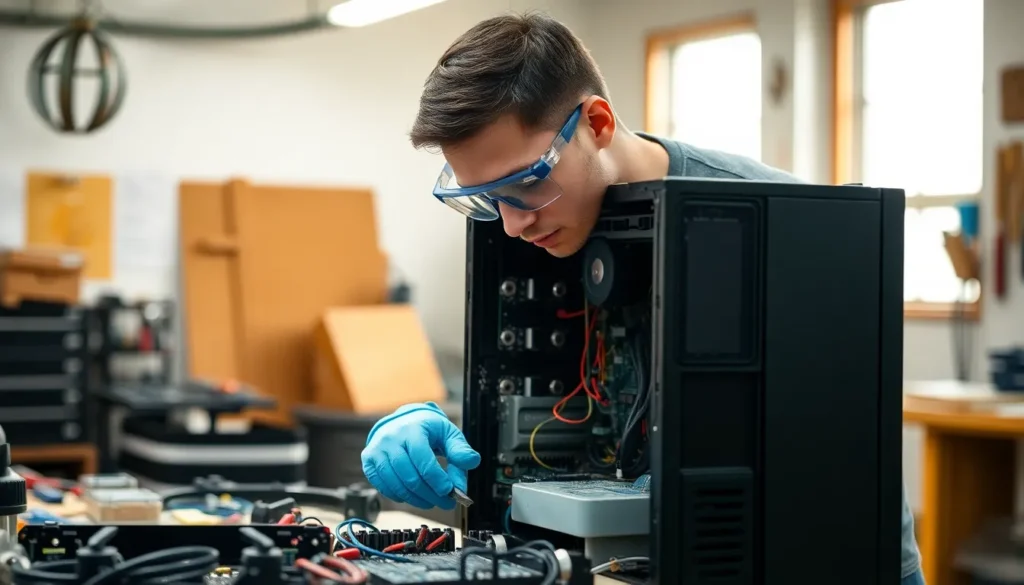Table of Contents
ToggleIn a world where gadgets seem to age faster than fine wine, hardware restoration emerges as the superhero we didn’t know we needed. Imagine breathing new life into that dusty old computer or reviving the once-mighty gaming console that’s been gathering dust in the attic. With a little elbow grease and some know-how, it’s not just possible; it’s downright satisfying.
Overview of Hardware Restoration
Hardware restoration focuses on reviving and upgrading older devices. This process enhances performance and extends the lifespan of gadgets, like computers and gaming consoles. Various techniques contribute to effective restoration, including cleaning, repairing, and replacing components.
Cleaning plays a crucial role in maintenance. Dust accumulation negatively affects performance, leading to overheating issues. Regular cleaning can prevent these problems, ensuring devices operate smoothly.
Repairing damaged parts often improves functionality. For instance, fixing broken screens or replacing worn-out keyboards can significantly enhance user experience. Assessing component functionality helps identify areas for repair, directing efforts where they matter most.
Upgrading hardware also benefits older devices. Adding more RAM or switching to an SSD can boost speed and efficiency. Such upgrades offer a cost-effective way to make outdated devices competitive with newer models.
Furthermore, the process encourages users to learn about their devices. Gaining knowledge about hardware components fosters a deeper understanding of technology. This understanding can lead to better decision-making regarding future upgrades or repairs.
Ownership of the hardware restoration process instills a sense of accomplishment. Revitalizing old machines transforms them into valuable tools once again. Many find joy in the challenge of restoring a gadget, celebrating the journey from obsolete to functional.
Resource availability, including online tutorials and community forums, supports enthusiasts in their restoration efforts. Engaging with other hobbyists fosters knowledge sharing and encourages collaboration. With the right approach, hardware restoration can become an enjoyable and enlightening experience.
Importance of Hardware Restoration

Hardware restoration plays a crucial role in revitalizing outdated devices. Engaging in this process not only extends the lifespan of gadgets but also enhances their overall functionality.
Benefits of Restoring Hardware
Restoring hardware offers multiple advantages. Users experience a deeper understanding of their devices while developing valuable technical skills. Bringing an outdated computer back to life improves performance, often allowing the device to meet modern demands. Additionally, hardware restoration fosters creativity, as individuals can personalize their devices with unique upgrades. A sense of community often emerges among enthusiasts, as they share tips and support each other through forums and social media.
Cost-Effectiveness of Restoration
Restoring hardware provides significant cost savings. Upgrading specific components, such as SSDs or RAM, often costs considerably less than purchasing a new device. Users can allocate a budget for selective upgrades instead of scrambling for funds for a complete replacement. A focus on repairs over replacement leads to sustainable tech practices, reducing electronic waste. With proper restoration, older devices can perform comparably to newer models while avoiding the expense of constant upgrades.
Common Methods of Hardware Restoration
Effective hardware restoration relies on various methods to breathe new life into outdated devices. Two common techniques are cleaning and component replacement.
Cleaning Techniques
Regular cleaning prevents dust accumulation, which leads to overheating and performance issues. Users should start by unplugging devices and using compressed air to blow out dust from vents and components. Microfiber cloths effectively capture dirt without damaging surfaces. Screens benefit from cleaning solutions designed for electronics, ensuring a streak-free finish. Removing grime from keyboards and ports enhances functionality and overall user experience. It’s essential to establish a cleaning routine, keeping devices in optimal condition.
Component Replacement
Component replacement plays a significant role in hardware restoration. Users often replace broken screens, faulty fans, or worn-out keyboards with compatible parts. Upgrading internal components, such as hard drives or RAM, significantly boosts performance. Selecting high-quality replacement parts ensures reliability and longevity. Seeking guides or tutorials aids in the replacement process, helping enthusiasts navigate any challenges. Taking the time to replace or upgrade specific components yields impressive results, making older devices feel brand new.
Tools and Equipment for Hardware Restoration
Effective hardware restoration relies on specific tools and equipment. These items help bring outdated devices back to life.
Basic Tools
- Screwdrivers: A precision screwdriver set accommodates various screw types in gadgets.
- Pliers: Needle-nose pliers assist with tight wiring and component adjustments.
- Tweezers: Use tweezers for managing small parts and delicate components.
Cleaning Supplies
- Compressed Air: This tool blasts dust from hard-to-reach areas, preventing overheating.
- Microfiber Cloth: Use these cloths with specialized cleaning solutions for screens and keyboards.
- Isopropyl Alcohol: It helps remove grime and fingerprints without leaving residue.
Repair Equipment
- Soldering Iron: A soldering iron is vital for repairing connections on circuit boards.
- Multimeter: This device checks voltage and current, aiding in diagnostics of faulty components.
- Desoldering Pump: Use this tool to remove soldered connections reliably.
Replacement Parts
- Hard Drives: Upgrading to a solid-state drive significantly boosts performance.
- RAM Modules: Notable improvements come from adding more RAM for enhanced multitasking.
- Cooling Fans: Replacing old fans helps maintain optimal temperatures for device longevity.
Organizational Supplies
- Storage Bins: Use bins to keep screws and components organized during restoration.
- Labeling System: A labeling system helps track parts and their respective devices.
Investing in the right tools and equipment streamlines the restoration process, making it more efficient and effective. Proper organization and selection lead to better results in revitalizing older devices.
Challenges in Hardware Restoration
Restoring hardware poses specific challenges that enthusiasts encounter during the revitalization process. One primary issue involves sourcing compatible parts. Older devices often require components that are no longer in production, making it difficult to find replacements. This scarcity can lead to increased costs and extended search times.
Time constraints also play a significant role. Both novice and experienced restorers face time pressures that can complicate the restoration journey. Finding adequate time for extensive cleaning, repairs, and upgrades proves challenging, particularly for those with busy schedules.
Skill gaps can hinder progress. Some users may lack the technical expertise needed to perform nuanced repairs or upgrades. Providing access to elaborate tutorials and guides doesn’t eliminate the necessity for hands-on experience. Users might feel overwhelmed by intricate processes like soldering, which impacts their confidence.
Evaluating the overall condition of a device also presents difficulties. Users sometimes underestimate the extent of wear and tear, leading to incomplete assessments. Acknowledging the hidden issues, such as corrosion or internal damage, remains crucial for effective restoration.
Warranty considerations add another layer of complexity. Modifying devices can void warranties, placing risk on enthusiasts who wish to restore functionality. Balancing the potential benefits of customization against warranty implications necessitates careful consideration.
Lastly, managing expectations plays a vital role. Enthusiasts often envision flawless restorations, yet the realities can differ. Accepting that not every restoration yields perfect results helps maintain motivation and encourages a learning mindset. Each challenge faced during hardware restoration contributes to the growth and fulfillment that many users find in the process.
Hardware restoration offers a unique opportunity to breathe new life into outdated devices. It not only enhances performance but also promotes sustainable practices by reducing electronic waste. The satisfaction derived from reviving a once-neglected gadget is unparalleled.
With the right tools and techniques anyone can embark on this rewarding journey. Overcoming challenges along the way fosters a sense of accomplishment and community among enthusiasts. As technology continues to evolve the skills gained through hardware restoration remain invaluable. Embracing this practice not only extends the lifespan of devices but also enriches the user experience.







